ENTERING THE TWILIGHT ZONE
/13 Comments/in Gardening, Planning, Vegetables/by Lee ReichBigger Garden, Same Size
Over the years I’ve greatly expanded my vegetable garden, for bigger harvests, without making it any bigger. How? By what I have called (in my book Weedless Gardening) multidimensional gardening.
I thought about this today as I looked upon a bed from which I had pulled snow peas and had just planted cauliflower, cabbage, and lettuce. Let’s compare this bed with the more traditional planting of single rows of plants, each row separated by wide spaces for walking in for hoeing weeds, harvesting, and other activities. No foot ever sets foot in my beds, which are 3 feet wide. Rather than the traditional one dimensional planting, I add a dimension — width — by planting 3 rows up that bed. Or more, if I’m planting smaller plant such as carrots or onions.
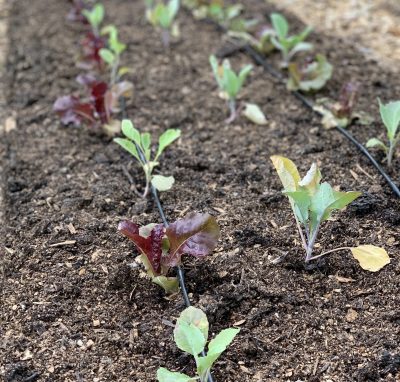
Let’s backtrack in time to when the bed was home to peas. Oregon Sugar Pod peas grow about 3 feet tall, so after planting them in early April, I made accommodations for them to utilize a third dimension in that bed, up. A three foot high, temporary, chicken wire fence allowed them to grow up, flanked on one side by a row of radishes and on the other side by a row of lettuce.
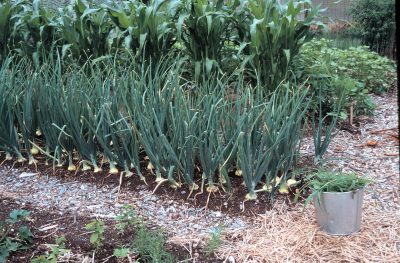
60 pounds of onions in 33 square feet!
There you have it, 3 dimensions. The bed length. The bed width, only three feet wide, with three or more rows down its length. And up.
A Fourth Dimension
Three dimensions isn’t the end of the story for multidimensional gardening. Time is another dimension. Neither peas nor radishes nor lettuce, occupy any bed for a whole season. Peas peter out in hot weather which, along with longer days, tells radish and lettuce plants that it’s time to go to seed. Those conditions tell me that radish roots are getting pithy and lettuce gets bitter, so out they go.
In my planting of cabbage, cauliflower, and lettuce, closer planting is possible because it allows room for longer maturing plants to expand as quicker maturing plants get harvested and out of the way. The middle row of the bed is planted to Charming Snow cauliflower, which will be ready for harvest around the first half of September. I can’t dawdle with that harvest because, left too long, cauliflower curds become loose and quality plummets.
I’ve planted Early Jersey Wakefield cabbage — an heirloom variety noted for its flavor — in a row eight inches away from the row of cauliflowers. The plants in the cabbage row are staggered with those in the cauliflower row, putting a little more space between plants from one row to the other. Early Jersey Wakefield will mature towards the end of September; no need to run out and harvest them all once they’re ready. In cool weather, the heads stay tasty and solid right out in the garden.
The row of Bartolo cabbage — a good storage variety — flanks the cauliflower on the other side of the bed. Bartolo requires 115 days to maturity.
Between each of the cabbage plants I’ve transplanted one or two lettuce seedlings. They’ll be ready for harvest and starting to get out of the way within a couple of weeks.
Mixing and Matching
How long a vegetable takes to mature, what kind of weather it likes, and the length of the growing season all need to be considered in order to make best use of four dimensions in the vegetable garden. Doing so, it’s often possible to grow three different crops in the same bed in a single season.
Here’s a table I made up listing some combinations that have worked well in my planting beds according to preferred temperature (cool or warm) and time needed until harvest (short, medium, or long season). That’s for here in New York’s Hudson Valley, with a growing season of about 170 days.

For example, looking at the first group, a tomato bed could start with lettuce, which will be out of the way by the time tomato transplants have spread to need the space. An example from the second group would be a bed with an early planting of turnips followed by a planting of okra followed by a planting of spinach.
A big advantage of these mixed plantings is that they present less of a visual or olfactory target for pests to hone in on, and they cover the ground enough to shade it to limit weed growth.
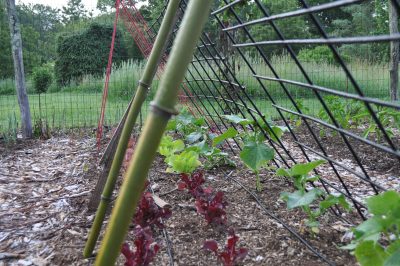
Lettuce and cucumbers

Carrots and lettuce following early corn
And Finally, the Twilight Zone, But Not For Now
Is it possible to find yet another dimension in the vegetable garden, a dimension beyond space and time? The Twilight Zone. Sort of. This fifth dimension is made up of a few tricks designed to find time where it is not, tricks meant to add days or weeks to the beginning and/or end of the growing season. But mid-July isn’t the time to detail ways of adding this dimension.
Trying to fill every available niche of physical space and time in the vegetable garden is like doing a four- (or is it five-?) dimensional jigsaw puzzle. Assembling this puzzle can sometimes bring on as much frustration as doing a real jigsaw puzzle. When I began gardening, I would sometimes get overwrought trying to integrate every multidimensional “puzzle” piece into every square inch of garden. Then I learned: When in doubt, just go ahead and plant.
BERRIES & ASPARAGUS REDUX
/11 Comments/in Fruit, Vegetables/by Lee ReichBerry Enticing
Berries are making it harder to get things done around here. Not because they are so much trouble to grow, but because I’ve planted them here, there, and everywhere. Wherever I walk I seem to come upon a berry bush. Who can resist stopping to graze? This year is a particular bountiful year for berries.
I can’t even walk to my mailbox without being confronted. First, there are lowbush blueberries hanging ripe for the picking over the stone wall bordering the path from the front door.  The wall supports the bed of them planted along with lingonberries, mountain laurels, and rhododendrons. These plants are grouped together because they are in the Heath Family, Ericaceae, all of which demand similar and rather unique soil conditions. That is, high acidity (pH 4 to 5.5), consistent moisture, good aeration, low fertility, and an abundance of soil organic matter. The small blueberries send me back to many summers ago in Maine when a very young me hiked in the White Mountains and picked these berries from plants growing amongst sun-drenched boulders. Care needed: mulching in autumn, and cutting a portion of the planting to the ground with a hedge trimmer every second or third winter.
The wall supports the bed of them planted along with lingonberries, mountain laurels, and rhododendrons. These plants are grouped together because they are in the Heath Family, Ericaceae, all of which demand similar and rather unique soil conditions. That is, high acidity (pH 4 to 5.5), consistent moisture, good aeration, low fertility, and an abundance of soil organic matter. The small blueberries send me back to many summers ago in Maine when a very young me hiked in the White Mountains and picked these berries from plants growing amongst sun-drenched boulders. Care needed: mulching in autumn, and cutting a portion of the planting to the ground with a hedge trimmer every second or third winter.
A few feet further the path ends and I come to the driveway, and here’s a 50 foot long hedge of Nanking cherries (berry size, but a drupe fruit, not a berry), whose season is almost over. For the past few weeks the stems were so solidly clothed in cherries that you could hardly see the branches. The cherries have a very refreshing flavor on the spectrum between that of sweet and tart cherries. Care needed: winter pruning — very nonexacting — to keep the bushes from growing too large.
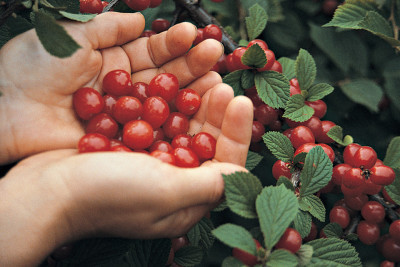
Perhaps later, once back in the house, I’ve got to walk out the back door to the compost pile. Hmmm. Gooseberry plants are enticing me with their stems that are arching to the ground under their weight of berries. Can’t pick a little from just one plant. I’ve got to eat a few of each of the over dozen varieties. My favorites? Hinnonmaki Yellow, Poorman, Black Satin, Red Jacket, and Captivator.
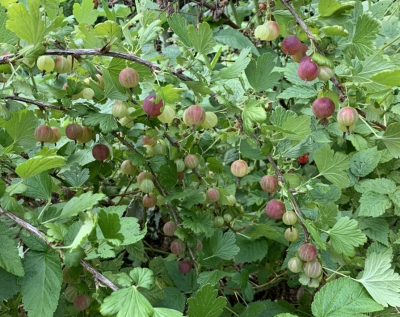
Poorman gooseberry
It’s a funny thing about gooseberries. If I pick a bowl of the berries and then bring them indoors to eat, they don’t taste as good as the one’s eaten bushside. It’s not just me; Edward Bunyard, in his 1929 book The Anatomy Of Dessert, wrote that the “Gooseberry is of course the fruit par excellence for ambulant consumption.”
Care needed: winter pruning to get rid of the very oldest stems and make way for younger ones; and to reduce the number of newest stems if they are overly abundant.
Okay, I finally made it to the compost pile. Now to check what’s going on in the greenhouse. Uh oh, I have to walk past black currants, one of my favorite fruits and now at their peak flavor. Their flavor is intense, intensely delicious to me. I grow mostly the variety Belaruskaja, which has just the right amount of sweetness to balance its almost resin-y flavor. Care needed: annual winter lopping to the ground of all two-year-old and some one-year-old stems.
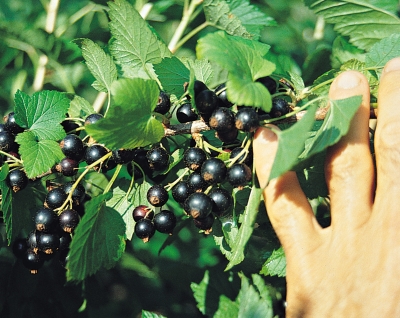
And right next to the black currants are black raspberries, also now at their peak flavor. The heavy crop of berries are arching some of the longest stems within reach of our ducks. I can share a few berries with them. Black raspberries grow wild all over the place in much of this part of the country. Wild ones are good. I prefer the named variety, Niwot, that I planted because it is one of two varieties that can bear two crops each season. For fruit size, flavor, and abundance, it’s worth growing even for just its summer crop. Care needed: summer pinching of tips of new stems to induce branching; winter pruning to cut away all two-year-old stems and thin out one-year-old stems, and to shorten branches to 18 inches; and tying stems to posts to hold them up.
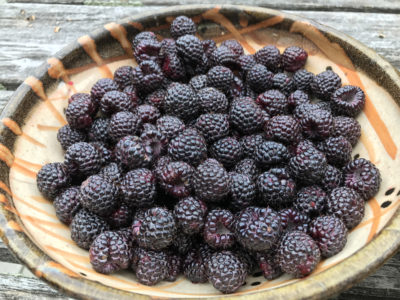
Finally, I make it to the greenhouse. Leaving it, I’m confronted with two mulberry trees, the variety Illinois Everbearing and the variety Oscar (what a funny name for a fruit tree). No danger of the mulberries delaying my progress because I know that the birds are taking all of them. Illinois Everbearing, true to its name, will continue to bear into August. Perhaps by then the birds will tire of them or move on to other fruits, leaving some for me.
One more enticement, one of the best, before going back indoors — Fallgold raspberry.  This variety, carrying genes of some species of Asian raspberry, has a sweet, delicate flavor unlike any other variety. Physically, the berries are similarly sweet and delicate, a pale, pinkish yellow. Their fragility makes them a poor commercial fruit so you won’t see them for sale. Grow them.
This variety, carrying genes of some species of Asian raspberry, has a sweet, delicate flavor unlike any other variety. Physically, the berries are similarly sweet and delicate, a pale, pinkish yellow. Their fragility makes them a poor commercial fruit so you won’t see them for sale. Grow them.
Asparagus Cutting?
Seems like last week’s blog post about my method for reducing weeds in the asparagus patch caused a lot of confusion. I wrote that I cut down all the spears before applying compost and wood chips, and many people thought that was not supposed to be done until autumn.
During the harvest season, which here is from the time the spears first show until the end of June, the spears are constantly being cut down for eating. All are regularly cut, even those too spindly for eating. Doing so helps starve out asparagus beetles, which are gone by July.
So consider my final, early July lopping back of any and all spears just like a final harvest. From then on, spears are left grow to their heart’s content, fueling the roots for next year’s spring and early summer harvest. The bed gets its final cutting down in autumn, when the ferns yellow to indicate that they’re no longer feeding the roots.
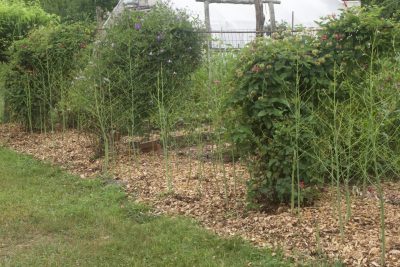
I was a little nervous about the compost plus wood chip smothering asparagus plants in addition to weeds. Not to worry. It’s a few days after the treatment and some fronds are already a few feet high. And so far, no weeds.
More details about growing and use of berry (and other) fruit plants can be found in my books Grow Fruit Naturally and Landscaping with Fruit.
“SPARROWGRASS” RENOVATION
/26 Comments/in Soil, Vegetables/by Lee ReichThe Season Ends
Asparagus season has ended here now, after more than two months of harvest. From now till they yellow in autumn, the green fronds will gather sunlight which, along with nutrients and water, will pack away energy into the roots, energy that will fuel next year’s harvest.
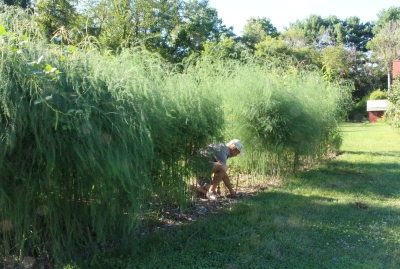
In addition to dealing with the weather, the plants have to contend with weeds. I have to admit, despite being the author of the book Weedless Gardening, that my asparagus bed each year is overrun with weeds, mostly two species(!) of oxalis, creeping Charlie, and various grasses. Also weeds parading as asparagus, self-sown plants. This, even though I planted all male varieties. Any batch of male plants typically has a certain, low percentage of female plants. (Still, my garden is weed-less even if it’s not weedless.)
I always wondered about the recommendation to plant asparagus crowns in deep trenches that are gradually filled in with soil as the new plants grow. I read that one reason is that crowns deep in the soil results in thicker, albeit fewer and later, spears. But as if to decide for themselves, research also shows that , over time, shallowly planted crowns naturally settle deeper into the ground, and deeply planted crowns inch upwards.

Another reason for deep planting is, perhaps, to protect the crown from tiller blades or hoes. I don’t till and, since the plants anyway take the matters in their own hands, I set my asparagus, years ago when I planted them, just deep enough to get the crowns under the ground.
Weed Control(?) for Next Year
But back to the weeds in my asparagus bed . . . This year I’m determined to get more of the upper hand with weeds. To whit: Yesterday I cut everything — weeds and asparagus — in the bed as low as possible. A bush scythe, which is a scythe with a short, heavy duty blade, does this job easily and quickly; a weed whacker might also work. One year a battery powered hedge trimmer got the job done. For me, the scythe works best.
In years past, I would cut everything to the ground, as I did this year, and then I’d top the bed with a couple of inches of wood chips.
This year, to get better weed-less-ness and to offer the asparagus plants a treat as thanks for the many spears that went into cold soup, hot vegetable dishes, and the freezer, I offered them compost. Although I make lots of compost, that compost is generally reserved for beds within the vegetable garden proper and potting mixes as well as, this year, my newly planted grape vines, and pear and apple trees.
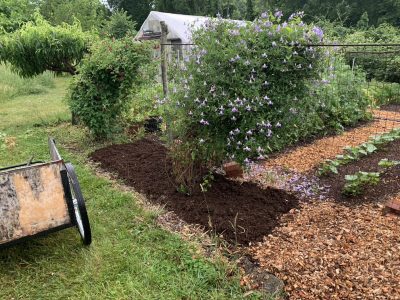
Asparagus is worth it, so I dug into my most finished compost bin, filled up two garden carts, and slathered a one-inch layer of compost over the whole bed. That inch of dense, dark compost should go a long way to smothering small weeds, which have little reserve energy. The compost then got topped with a couple of inches of wood chips. 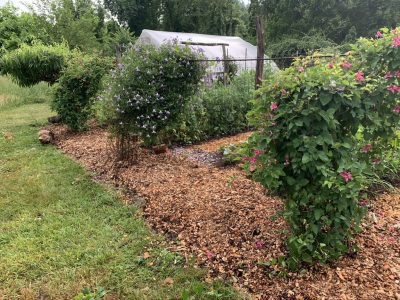 The compost will nourish the asparagus . . . and the weeds, most of which I hope will be sufficiently young or weakened to not push up through the compost and the wood chips to light.
The compost will nourish the asparagus . . . and the weeds, most of which I hope will be sufficiently young or weakened to not push up through the compost and the wood chips to light.
Compost Needed
That was a lot of compost to part with. No problem, because I’ve also been making lots of compost. Plus, a few bins I built last year, each with about one-and-half cubic yards of compost, are ready to use or will be so in the coming weeks.
The bins themselves are made from 1×6 boards of composite wood (a mixture of waste wood, recycled and new plastic, and some type of binding agent), such as used for decking, notched to stack together Lincoln-log style. It keeps moisture and heat in, and scavengers and weeds more or less out, and doesn’t degrade, as did my previous wood bins.
I feed my compost pets — earthworms, fungi, bacteria, and other organisms — hay from my small field, manure from a nearby horse farm, kitchen waste, old garden plants, and anything else biodegradable. The latter category has included old leather shoes and garden gloves, jeans, and, as an experiment, biodegradable(?) plastic spoons.
The compost also gets occasional sprinklings of soil, to add bulk, and ground limestone. Periodic liming is generally needed to counteract the acidity of most soils of northeastern U.S.; my soil gets limed indirectly, via the compost.

Water is commonly the most limiting ingredient in home composts. Lots of water is necessary to percolate down into a pile. Rather than getting bored with a hose wand, after finishing an extended composting session, I set up a small sprinkler on the pile, whose spread is as wide as the pile, to gently water for about 20 minutes.
Of course, the devil is in the details: how much of each ingredient to add. Not to worry, though. Any pile of organic materials will eventually turn to compost.
For my piles, I check moisture with a REOTEMP long stem moisture meter and monitor progress with a long stem compost thermometer. This time of year temperatures of the piles soar to 150°F within a few days.
My asparagus bed is worth all this.

